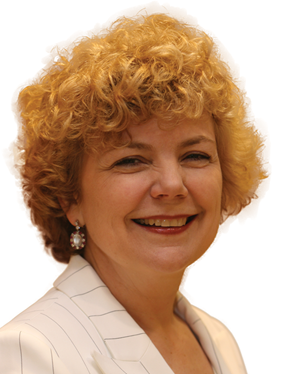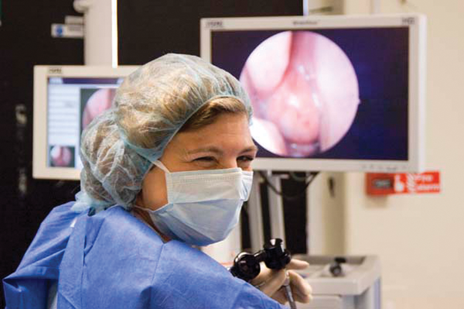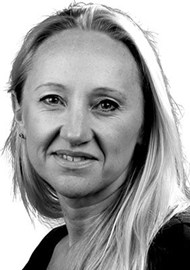Valerie Lund is Professor of Rhinology at the Ear Institute, University College London and is an Honorary Consultant ENT Surgeon at the Royal National Throat Nose and Ear Hospital (Royal Free Trust), Moorfields Eye Hospital, University College Hospital and Imperial College. She deals with all nose and sinus conditions with a particular interest in sinonasal tumours and has been involved in endoscopic sinus surgery and its extended applications since the early 1980s. Professor Lund was awarded a CBE for services to medicine in 2008 and is Master Elect for BACO 2018. Here she speaks to Claire Hopkins about her latest book, Tumors of the nose, sinuses and nasopharynx, and discusses the changes in this area of surgery over the last decades and the motivations and challenges involved in writing a medical textbook.

Tumors of the nose, sinuses and nasopharynx is in part an update of Tumours of the Upper Jaw published in 1993 – what do you think has been the biggest change in the last 20 years?
There have been significant improvements in the imaging, pathology techniques and obviously surgical techniques. Conventional craniofacial resections are done less often these days as many cases can be done endoscopically. Revising the book allowed us a 35 year review of what has gone before and we have prospective data on 35 years of craniofacial work, so it is a great cohort to compare with the modern techniques.
As far as the non-surgical oncology goes, I am a little bit more cynical about that. We have always had very good radiotherapy for the nose and sinuses where I have worked. The additional benefits of IRMT and proton beam remain to be proven. However, some things like immuno-modulation for melanomas might prove to be worthwhile in the future.
“Revising the book allowed us a 35 year review of what has gone before and we have prospective data on 35 years of craniofacial work, so it is a great cohort to compare with the modern techniques.”
What has been your most memorable case in that time?
That is an impossible question to answer. I would say that they are all memorable in their way, actually. The thing that I find memorable about almost all of the patients, is that they come with relatively minor symptoms; a bit of proptosis, some sero-sanguinous discharge or nasal blockage. They have no knowledge that tells them that this could be a sign of malignancy, nothing to prepare them. The awfulness for all patients with nose and sinus tumours is they arrive with relatively minor symptoms and then somebody is telling them that they have got this appalling tumour which could kill them. It must be like your worst nightmare. I have had to do this so many times and the way in which patients deal with it is so often amazing; that for me is the most memorable but also the most shocking thing about it.
Valerie Lund in theatre, operating on a tumour.
What was your motivation for writing the book?
The motivation for writing this edition of the book was that three very good friends, one of whom happens to be my husband and William Wei who we have known for decades, are all coming towards the end of our careers and we have had cumulatively a unique experience of tumours in this area. We thought it was quite a good time to distil that experience. Obviously it is an update, it’s 20 years since the last book, so it was a good moment for all of us to do it. We were able from our own experience and knowledge of the literature to write it ourselves. The only areas where we felt we should obtain additional expertise were obviously the three chapters covering imaging and medical oncology / radiation.
How many centres do you think we need to provide care for this type of pathology?
This has been the subject of quite a lot of debate as you know. The difficulty is that the number is probably less than we think we need. Every registrar I speak to comes up and says “I want to be an anterior skull base surgeon”; the reality is that although it is very sexy and interesting, there are simply not enough cases to go around. I think that this is a difficulty that we are going to have to grapple with because it is one thing being a head and neck surgeon and another thing being an endoscopic surgeon. But being both is difficult. It is actually hard to get the knowledge of the unique natural histories of these tumours so what you do not want to do is just to move from doing CRS with endoscopes to doing tumours on the occasional basis because that will not, unfortunately lead to good results.
Do you worry that newer generations of surgeons brought up with endoscopic techniques will lose the ability to perform external operations or recognise when they are indicated?
Yes! While the book can’t fill in for experience, one of the aims of the book was to demonstrate the place for all approaches.
How do we collate experience to ensure best outcomes?
The most important thing is prospective data collection, either on a single centre basis, which is what we have done since the 1970s and why we have got all that information to work with, or in a collective way. That was one of the reasons for writing the European Consensus document [1], because I wanted to see if we could get a group of people of similar experience and ability whose data we could trust and get them to contribute from a variety of centres to a prospective database.
The reality is that a lot of surgeons like operating but they don’t like entering data so it hasn’t proved to be quite the resource that I would have liked it to be. I think it is a mindset but we have to collect information. It does not have to be a huge amount. For every patient that we have ever operated on using tumour surgery in this unit, we have the information on them. We must also resist the temptation to discharge patients.
While there is great pressure on us not to follow patients up, we really need to know what happens to them in the long term. That is the only way we will get the answers. We know that tumours like an olfactory neuroblastoma can come back many years later – 14 years is the latest I have had one come back despite regular imaging and examination so I know that it is new disease. It’s the same with adenocarcinoma, eight years is the longest interval for recurrence but if you pick it up, you can often salvage the patient. So you don’t learn about these tumours unless you follow them up for a very long time. Although the system is against that, as long as we do the surgery we should do it.
What is the future of printed textbooks?
I will have to think about this. I think it’s a generational thing. I personally like flicking through a book and I find it easier to locate what I am looking for. However, I completely understand that a younger generation will just search online for the item they are after and they achieve the same that I do with a hard copy. I think for the time being there is still a future for a printed text book, but I think that will change. The big advantage online is the ability to continuously update, whereas for the printed book you’ve got to produce another edition. I can see that in the future they might find it difficult to survive.
Given the rarity of many of the tumours described, do you worry that the book might have a limited target audience?
I don’t worry about it because I never expected to sell thousands of copies. It is all the more reason for doing the book actually, to hope that it will be a ‘go-to’ reference for people who have a particular interest in this topic or if they have encountered some special rarity.
What advice would you give to any prospective author thinking of writing a text book?
I would tell them that it is harder than they think, if they have never done one before and it requires an OCD personality and a sense of humour!
References
1. The European Position Paper on endoscopic management of tumours of the nose, paranasal sinuses and skull base. Rhinology 2010;S22:1-43.
Interviewed by Claire Hopkins.





